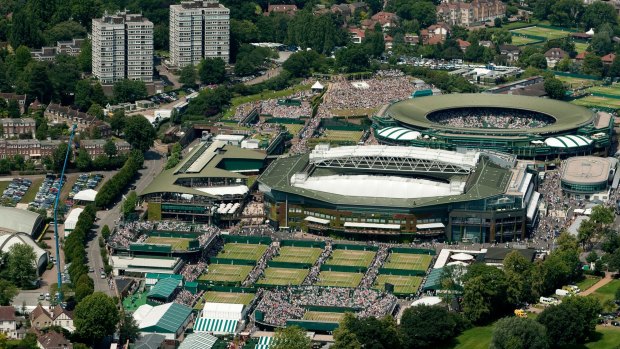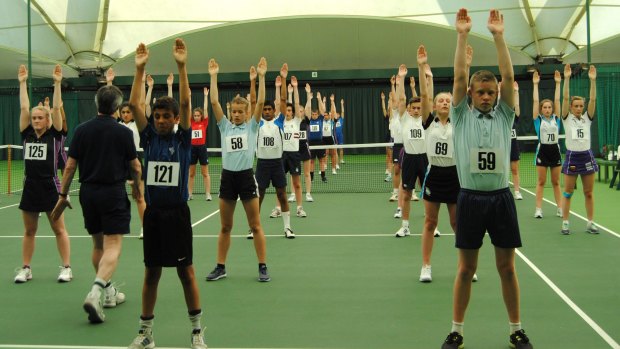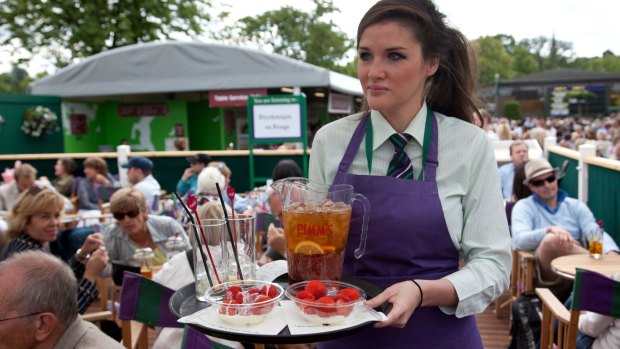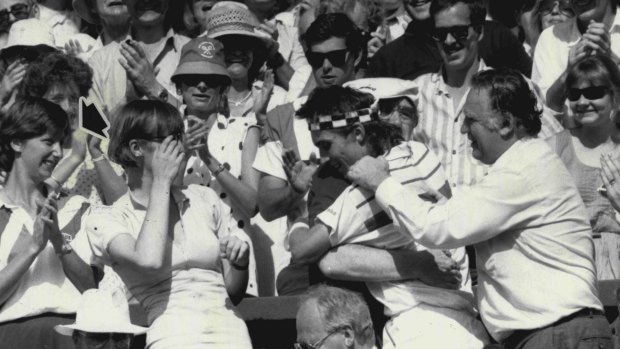This was published 5 years ago
Wimbledon visitor tours, England: Home to the world's best tennis museum
It's amazing what you can see on a three-hour tour of Wimbledon Lawn Tennis Club.
By Steve Meacham

Wimbledon: A mecca for tennis fans.Credit: Alamy
Early June in Wimbledon and ball boys and girls are learning how to roll the balls across the grass with military precision. Meanwhile, groundsmen are rehearsing how to cover a court in just 22 seconds when the inevitable rain falls during England's fortnight of strawberries and Pimm's Number 1.
Former champion Andy Murray – the first Brit to win Wimbledon since Fred Perry in 1936 – is hitting balls in a desperate attempt to contest this year's tournament after his hip injury.
And the head groundsman is holding a measuring stick, ensuring the net height will be precisely right when Roger Federer and Garbine Muguruza defend their titles, beginning on July 2.

Ball boys and girls prepare for the tournament.Credit: Alamy
It's amazing what you can see on a three-hour tour of Wimbledon Lawn Tennis Club.
There's the incomparable museum (easily the best tennis museum in the world), the unforgettable admission to Centre and Number One courts, the chance to admire the London skyline from "Henman Hill", plus a glimpse inside the BBC broadcasting studio.
Our host is James Cooper, who is in charge of the nine public tours that operate daily except for the two weeks of the tournament. (No, we don't get to see the players' changing rooms: "This is a members club so there will be players showering," says Cooper.)

Strawberries and cream with Pimm's, naturally.Credit: Alamy
The tour starts at the Fred Perry statue, outside the ivy-clad Centre Court, so familiar from TV screens. Workmen are erecting the various food stalls that will sell an estimated 28 tonnes of strawberries, 10,000 litres of cream and 320,000 glasses of Pimm's as well as 330,000 cups of tea and coffee.
First stop is the "new" Number One court, which holds 11,360 spectators (compared to the old court's 7328) and is having a fully retractable roof fitted. The old court – which used to be connected to Centre Court like a Siamese twin – has been demolished to make way for the Millennium building, home to players and media during the tournament.
Wimbledon has always walked a fine line between innovation (it began as a croquet club in 1868 before embracing the new Victorian fad for tennis) and tradition (obituaries of the graceful Brazilian star Maria Beuno – who won the "ladies singles" three times – revealed she wore bright pink knickers in the 1960s designed by Teddy Tingling just to flout the tournament's famous "all white" dress code).

Pat Cash hugs his father after victory at Wimbledon in 1987.Credit: Fairfax Media
During the tournament, one of the world's largest TV screens is attached to the side of Number One Court to serve the picnic-basket carrying fans who watch the action from Aorangi Terrace, named after Aorangi Park, the former Maori rugby training grounds that now house Wimbledon's practice courts.
It gained the nickname Henman Hill for the legion of Tim Henman fans who gathered here hoping their hero would end the "Fred Perry curse". Henman reached the semi-final in 2001, becoming the first British male to get that far since Roger Taylor in the 1970s, having defeated Roger Federer in straight sets.
Let's hasten on to the longest match ever played at Wimbledon. It took three days, from June 22 to 24, 2010, with American John Isner emerging victorious over France's Nicholas Mahut after a final set that ended 70-68. A plaque outside Number 18 court commemorates the event.
Look carefully and you'll also see one of the original horse-drawn rollers tucked in among the flower beds. The horses wore leather slippers to prevent them damaging the grass courts.
You can see one of the horse slippers in the Wimbledon Museum. Along with a wooden Dunlop Maxply racquet that Rod Laver used to win Wimbledon in the 1960s, and the Wilson T2000 steel racquet Billie Jean King employed to great effect from 1970 onwards.
Australians figure prominently in the museum, from Margaret Court and to John Newcombe and Ken Rosewall (still the best "gentleman" – along with Ivan Lendl – never to have won Wimbledon). And then there's Norman Brookes.
Norman who? "The father of Australian tennis" was Wimbledon champion in 1907, the first "overseas man" to defeat a Brit in the final. Brookes, also a top-class cricketer and golfer, became a sufficiently wealthy businessman to commission a replica of the trophy he was awarded (and not allowed to take home). His trophy is now back where it will probably be most appreciated – at the hall of fellow champions.
But before you think the place is stuffy, let me introduce John McEnroe. A hologram of McEnroe superbly encapsulates what many still regard as the golden age of tennis, paying homage to Bjorn Borg, Jimmy Connors, Pete Sampras, Andre Agassi, and the ever-changing nature of the sport.
Yet the biggest thrill, as ever, is walking onto Centre Court. There's the 75-seat Royal Box (surely Harry and Meghan will be there this year) and to the right, the entrance the players use to enter – and escape quickly if they lose – Centre Court. To the left you'll see what insiders call "the Cash gate".
In 1987, having beaten Connors in the semi final and Lendl in a straight set final, Pat Cash climbed into the players' box where he celebrated with family, coach and his girlfriend. There's no longer any need for such athleticism. The Cash gate allows a health-and-safety approved entry to the players' box for that post-victory celebration.
Steve Meacham travelled as a guest of Cathay Pacific and Visit Britain.
TRIP NOTES
VISIT
The Wimbledon Experience, see wimbledon-experience.com
Sign up for the Traveller Deals newsletter
Get exclusive travel deals delivered straight to your inbox. Sign up now.